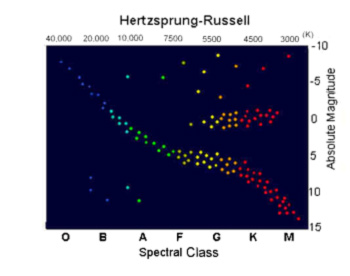BACKGROUND:
The Universe contains many components, which vary
considerably in size. In this exercise, students will use the internet to
research definitions for a number of astronomical objects, which are listed
in the "Vocabulary." Here are definitions to help you guide the
studentís work.
A galaxy is a large scale aggregate of stars,
plus some gas, dust, and possibly solar systems, which are held together by
gravity.
A globular cluster is a roughly spherical group
of hundreds of thousands to about a million stars, also held together by
gravity. Globular clusters seem to be made of very old stars.
A star is a ball of hot gas held together by
its own gravity. Gravity also causes stars to undergo nuclear fusion within
their interior. The energy release causes the star to shine. The energy of
fusion balances the starís gravity, preventing it from collapsing.
However, when a starís internal energy dwindles, the star may fade from
sight into a white dwarf star, or a neutron star, an extremely
high density object composed of 99% neutrons. Neutron stars are probably
remnants from supernova explosions. A pulsar is a rapidly spinning
neutron star. For reasons that are not fully understood, pulsars emit
regular bursts "pulses" of radiation.
Stars come in a variety of types. These include:
- Binary Stars - A system of two stars, orbiting around one
another. Binary (and other multiples) stars are very common. Astronomers
estimate that about half of all stars are members of multiple-star
systems.
- Main Sequence Stars - Stars on the "main sequence"
part of the Hertzprung-Russell (H-R) diagram, which classifies stars in
terms of absolute magnitude and temperature. Main sequence stars get
brighter as they get hotter. Our Sun and the majority of the stars in
the Universe are on the Main Sequence.
 Giant and
Supergiant Stars - Large stars that occur above the main sequence,
which are unusually large and cool. Supergiant stars are brighter than
giant stars.
Giant and
Supergiant Stars - Large stars that occur above the main sequence,
which are unusually large and cool. Supergiant stars are brighter than
giant stars.
A quasar (short for quasi- stellar radio source) is a
point source, no more than one light year in diameter that emits
tremendous amounts of energy, as much as hundreds of galaxies. Current
hypotheses suggest that quasars are powered by super massive black
holes.
A solar system is an arrangement of planets and other small
bodies around a central star or stars. The planets are kept in place by
gravity.
A planet is a spherical body which circles a star in a regular
orbit.
A comet is a kilometer-scale mass of frozen gas and rock which
orbits the Sun. Comets are leftovers from the formation of the Solar
System.
An asteroid is a mass of rock and minor amounts of frozen gas.
Like comets, asteroids are leftovers from forming the planets. Most
asteroids are in orbits between Mars and Jupiter. They range in size
from dust specks to over 300 kilometers in length.
PROCEDURE:
- Have the students define the words on the worksheet using the Internet
or other resources. We recommend the Internet because information on the
Universe continues to increase as we develop new ways to gather data.
Many sites on the Internet can allow students to easily learn the latest
astronomical discoveries. You can easily do a search on each of the
vocabulary words.
- You may want to use the following sites:
http://www.damtp.cam.ac.uk/user/gr/public/
Cambridge Relativity of Cambridge University. Discusses Cosmology, Black
Holes, Inflation, Cosmic stings, and more. Good illustrations and
graphics.